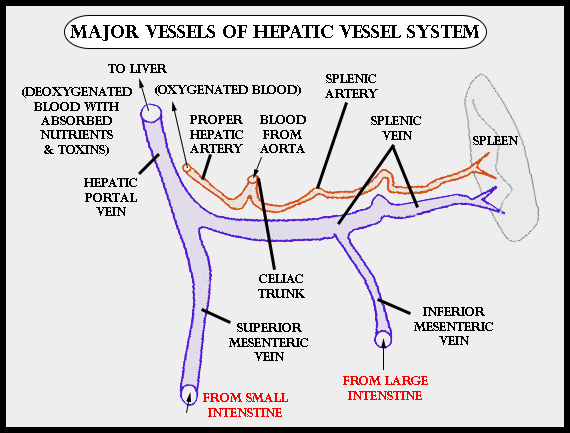
The blood vessel that begins and ends in capillaries
(a) Renal vein
(b) Renal artery
(c) Hepatic artery
(d) Hepatic portal vein
Answer
467.1k+ views
Hint: The blood vessel that begins and ends in capillaries is called a portal vein. Portal veins are not true veins as they conduct blood to the capillary beds present in the liver instead of the heart.
Complete answer:
There are two portal venous systems in the body-Hepatic Portal System and Hypophyseal portal system.
The hepatic portal system is a system of veins that involve the Hepatic portal vein and its tributaries.
The large veins that are part of the Hepatic portal system include:- Hepatic portal vein, Splenic vein, Superior mesenteric vein, and Inferior mesenteric vein.

The hepatic portal vein is a blood vessel that moves blood from the spleen, gallbladder, pancreas, and gastrointestinal tract to the liver.
Measuring about 8cm, it is located in the right upper quadrant of the abdomen, originating behind the neck of the pancreas.
It accounts for $75\%$ of the total blood flow in the liver.
Unlike other veins, the Portal vein does not drain into the heart. Instead, it is a part of the portal venous system that transports venous blood into other capillary systems(hepatic sinusoids) of the liver.
Additional information: The other type of portal system in the human body is the Hypophyseal portal system. It is a system of blood vessels involved in microcirculation at the base of the brain. It connects the hypothalamus with the anterior pituitary. Its function is to transport and exchange hormones between the hypothalamus and anterior pituitary.
So, the correct answer is ‘(d) Hepatic portal vein’.
Note: The liver has two blood supplies, the hepatic artery, and the hepatic portal vein. The hepatic artery is a short blood vessel that supplies oxygenated blood to the liver. It accounts for $25\%$ of blood flow in the liver.
Complete answer:
There are two portal venous systems in the body-Hepatic Portal System and Hypophyseal portal system.
The hepatic portal system is a system of veins that involve the Hepatic portal vein and its tributaries.
The large veins that are part of the Hepatic portal system include:- Hepatic portal vein, Splenic vein, Superior mesenteric vein, and Inferior mesenteric vein.

The hepatic portal vein is a blood vessel that moves blood from the spleen, gallbladder, pancreas, and gastrointestinal tract to the liver.
Measuring about 8cm, it is located in the right upper quadrant of the abdomen, originating behind the neck of the pancreas.
It accounts for $75\%$ of the total blood flow in the liver.
Unlike other veins, the Portal vein does not drain into the heart. Instead, it is a part of the portal venous system that transports venous blood into other capillary systems(hepatic sinusoids) of the liver.
Additional information: The other type of portal system in the human body is the Hypophyseal portal system. It is a system of blood vessels involved in microcirculation at the base of the brain. It connects the hypothalamus with the anterior pituitary. Its function is to transport and exchange hormones between the hypothalamus and anterior pituitary.
So, the correct answer is ‘(d) Hepatic portal vein’.
Note: The liver has two blood supplies, the hepatic artery, and the hepatic portal vein. The hepatic artery is a short blood vessel that supplies oxygenated blood to the liver. It accounts for $25\%$ of blood flow in the liver.
Recently Updated Pages
How do you factor x2 + x 20 0 class 9 maths CBSE

How do you solve y6x and 2x+3y20 using substitutio class 9 maths CBSE

Chipko movement originated in Gopeshwar in A 1953 B class 9 biology CBSE

The adjacent sides in the parallelogram are supplementary class 9 maths CBSE

The compound used in plastic industry is A Vinyl acetate class 9 chemistry CBSE

How do you solve for y in 2left y dfrac12 right 4left class 9 maths CBSE

Trending doubts
According to Bernoullis equation the expression which class 11 physics CBSE

Draw a diagram of nephron and explain its structur class 11 biology CBSE

Differentiate between calcination and roasting class 11 chemistry CBSE

A solution of a substance X is used for white washing class 11 chemistry CBSE

What is spore formation class 11 biology CBSE

10 examples of friction in our daily life




